Here in the United States, approximately 50% by weight of a beef cow and 55% of a pig make it to the grocery store shelves. That means almost half of each animal we slaughter doesn’t even have a chance to be a part of our food supply and, too many people, is not even considered food.
What happens when you just eat meat and not the whole animal
This unfortunate reality creates a host of problems. First, this system is not evolutionarily consistent. Our ancestors began consuming the entire animal approximately 2 million years ago. And, it is at that 2 million year mark that our ancestors’ brains and bodies developed to almost modern proportions on the back of the incredible nutrition that only the entire animal could provide. Consuming only half of the animal also poses a nutritional problem.
Even though meat is more nutrient dense and bioavailable than any plant on the planet, it is one of the least nutrient dense and bioavailable parts of an animal. The blood, fat, and organs pack a much bigger nutritional punch than the meat, and this means that by consuming half of our animals by weight, we are accessing less than half of the nutrition they can provide.
Finally, and, most importantly, killing an animal and using the entirety of it to nourish yourself and your family is, by all measures, a completely different thing than killing an animal and only using only half.
To take it one step further, participating in the process created a powerful, visceral connection. It is from this perspective that I am excited to share with you what happened after we removed the stomach from the goat to make callu di cabrettu in the mountains of Villagrande, Sardinia with Gisella Rubiu, Delia our translator, and shepherds Giovannia, Salvatore, and Andrea
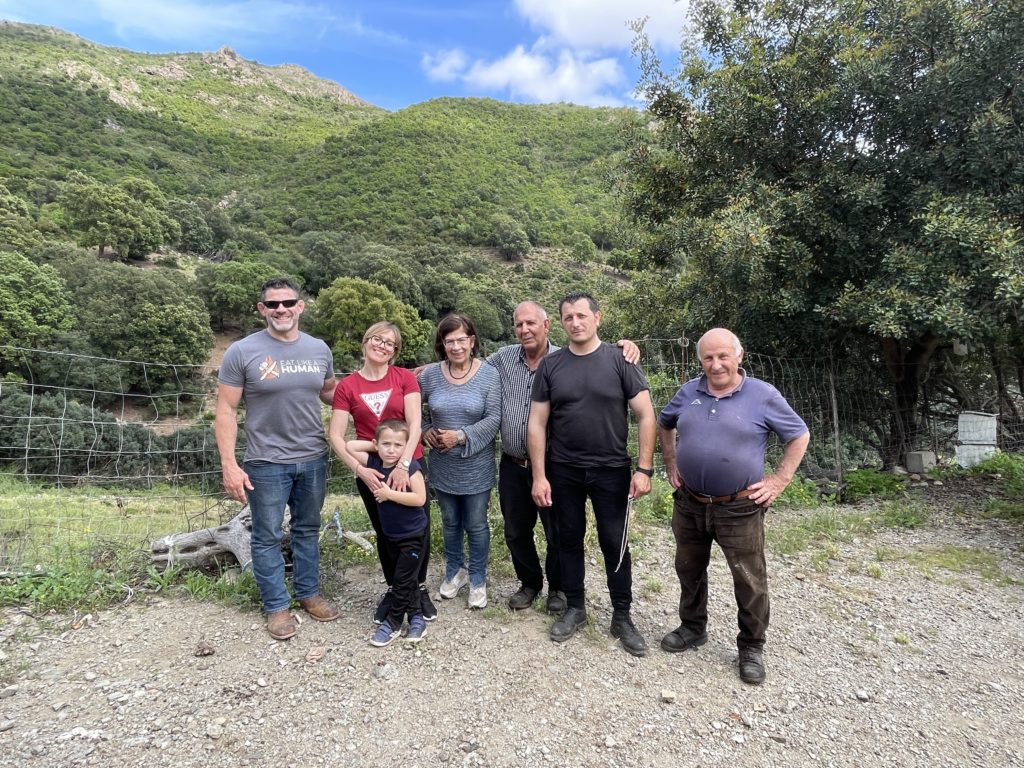
The beginning of butchering
Before I begin, I need to include two important steps skipped in my account of the callu di cabrettu experience.
The first took place right after the goat was killed and bled. Giovanni made a small incision at the base of its back leg to create a flap of skin approximately 2 inches long. He then picked up a small diameter stick which he pushed up through the hole made by the incision. While anchoring the leg by holding onto the skin flap he continued to push the stick several inches up between the bone and skin to create a vent. Finally, he placed his mouth on the hole and blew air through the vent which inflated the goat like a balloon. This step separated the muscle from the skin and made the subsequent skinning process much easier.
The second step took place after the skin was removed and the belly sliced open. Giovanni removed the mesentery or caul fat and reserved it for later use. Caul is used in traditional French cooking and, because it consists of fingers of beautiful fat, is nourishing and incredibly delicious.

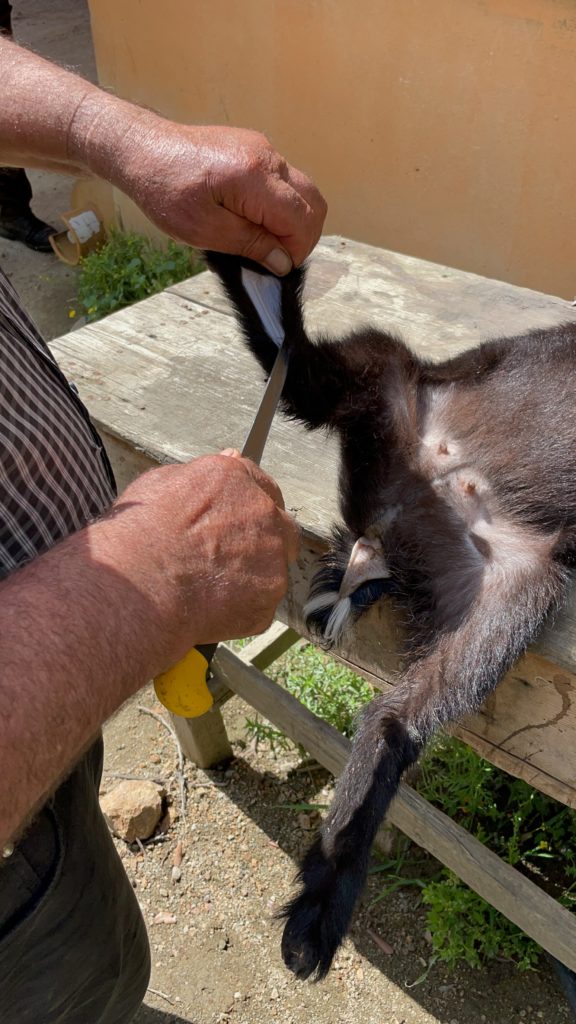
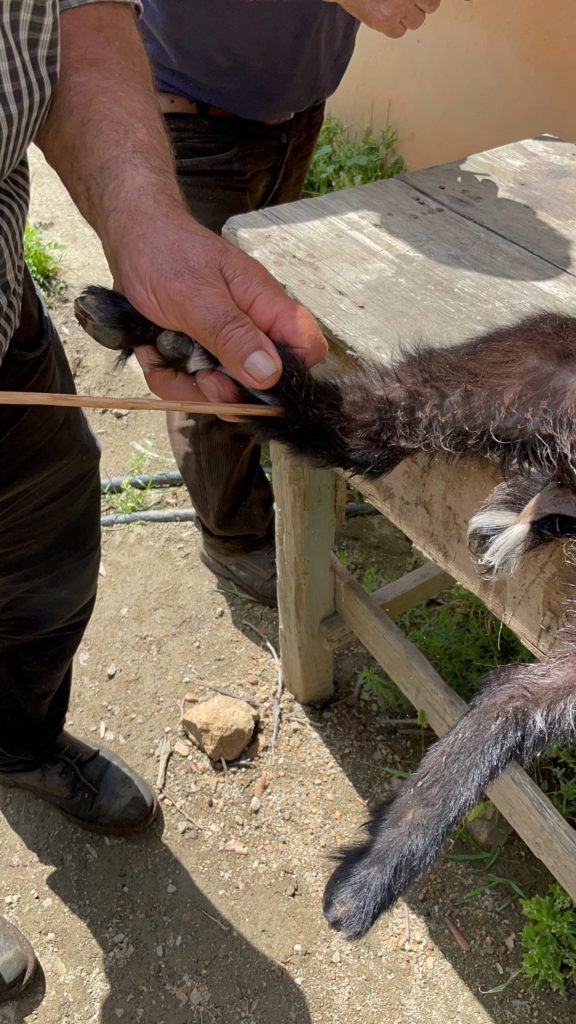
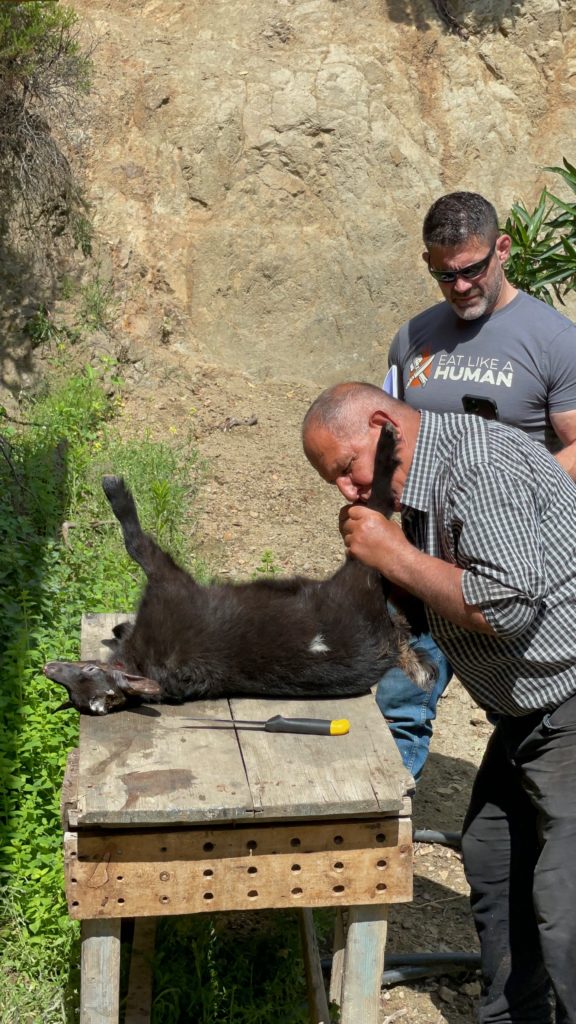

After callu di cabrettu the work begins
After we removed the stomach and hung it for callu di cabrettu, Giovannia began to remove the small intestines, which were freed on one end because they were no longer attached to the stomach. He expertly pulled the intestines with his right hand as he coiled it on his left (just like we would do with an extension cord or length of rope). Once all the small intestines, still full of chyme, were removed and coiled they were set aside on a hook for later use. Then, he removed the large intestines, squeezed them to expel the contents, then rinsed them with water. These were also set aside for later use. Giovannia then used his thumb and index finger to “pinch” the bile filled gallbladder and tossed it over the fence. The gallbladder is incredibly bitter and, along with the feet and skin was the only part of the animal we did not eat.
At this point, the only thing still holding the remaining organs in the body was the trachea. It was cut and the liver, spleen, heart, lungs were removed and handed over to Salvatore. The head was removed and set aside leaving only the kidneys and flesh remaining on the carcass. The goat was then cut in half and a kebab skewer stuck through one of the legs and out between the 3rd and 4th rib using a hole Giovannia made with his knife. This was repeated to load the other half of the goat on the skewer. Then the head was cut in half down the top and through sides leaving the jaw (mandible) intact. The head pried open and the head added to the skewer, which entered through one eye and exited out the other side. While all of this was happening, Andrea built a long fire on the ground and fed it with windfall collected from the surrounding forests until it was roaring and ready for cooking.
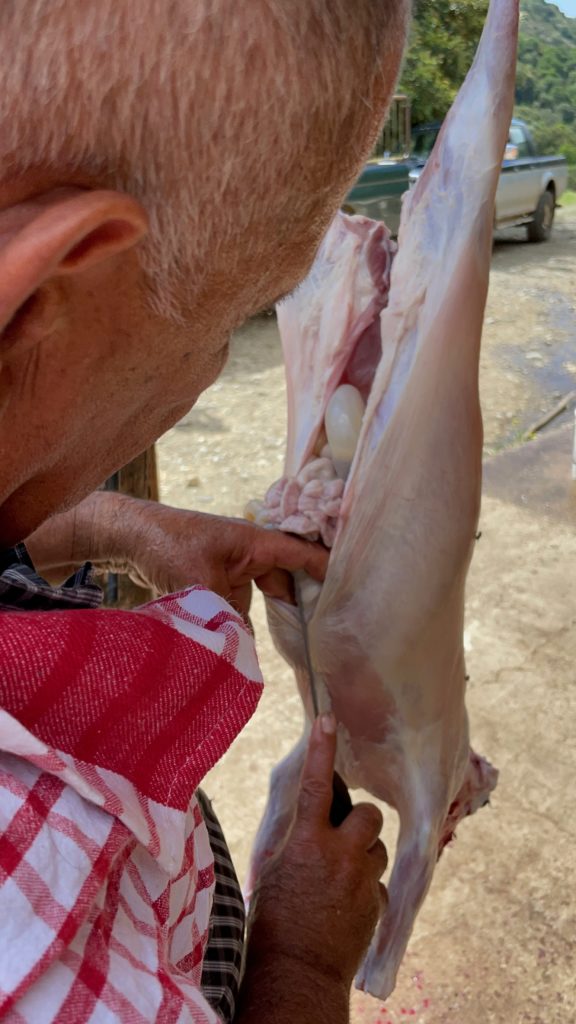
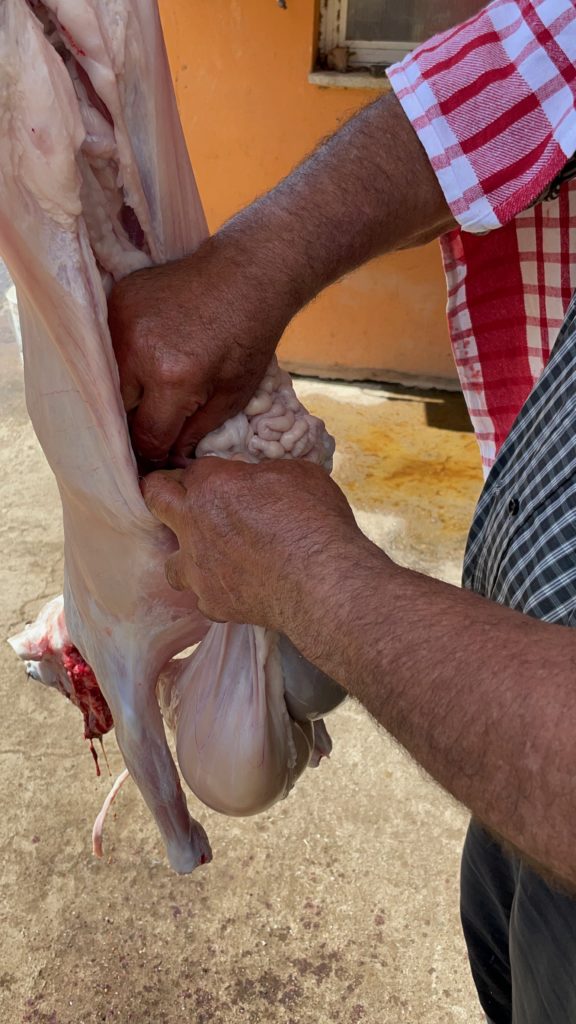
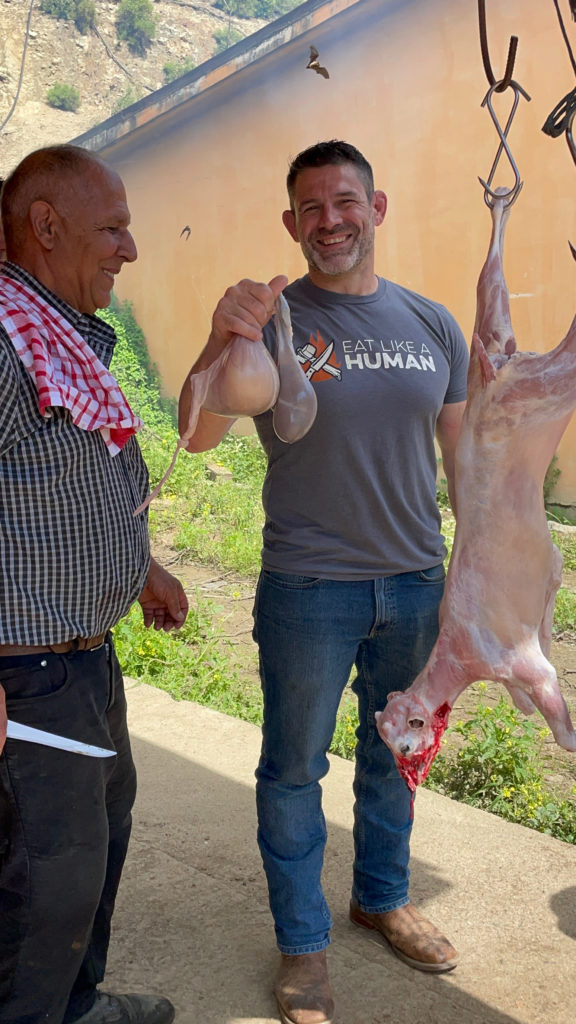
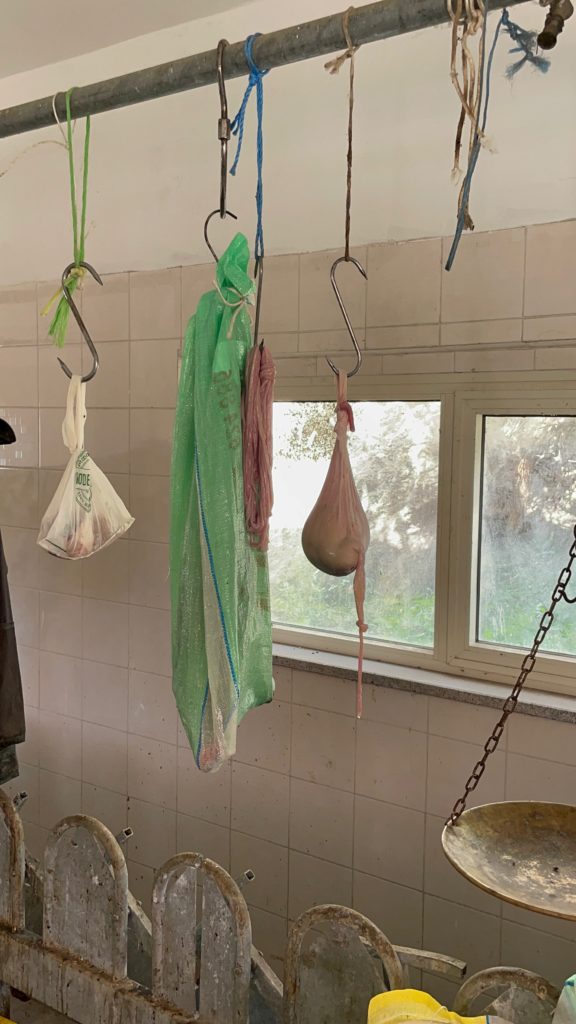
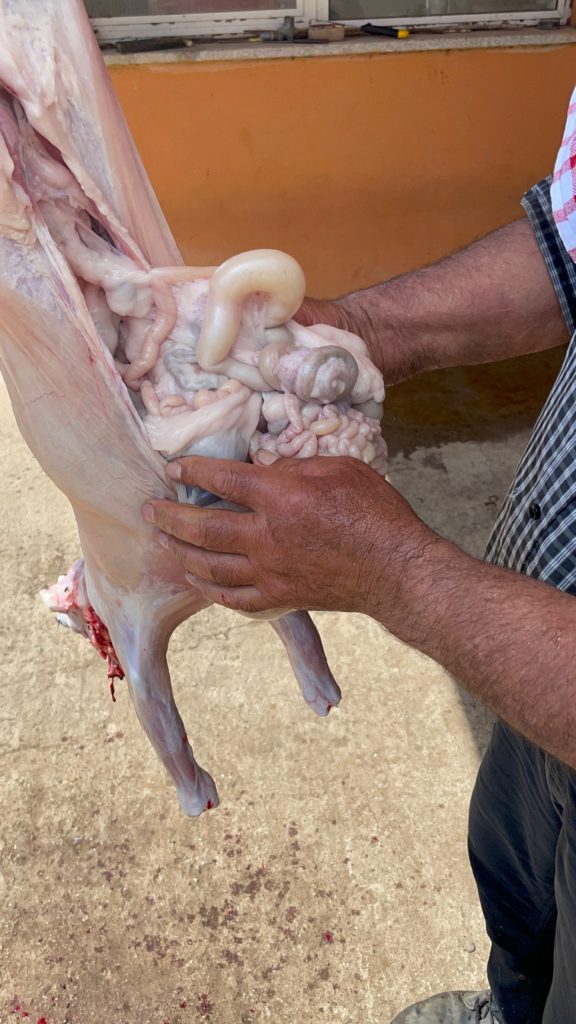
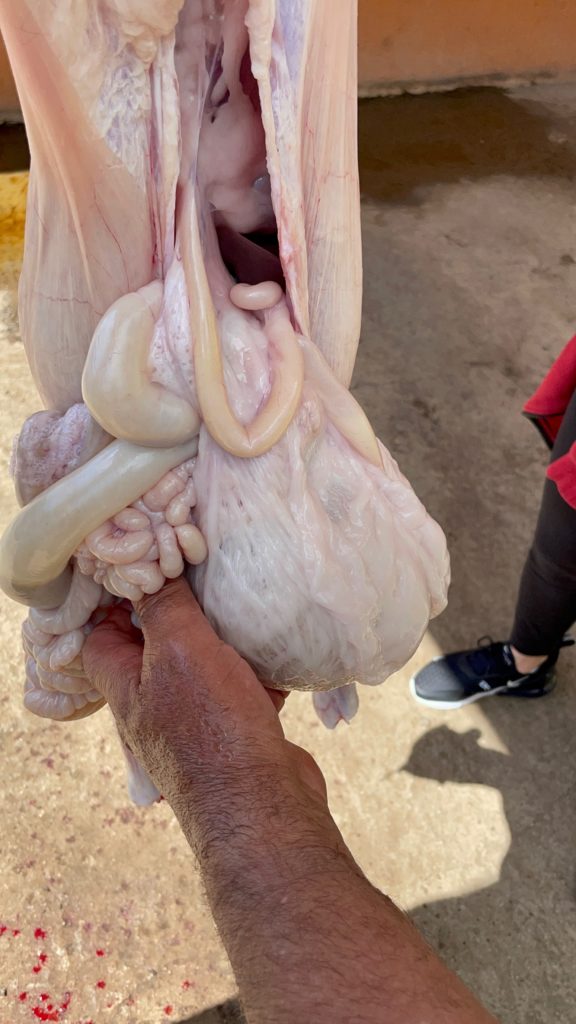
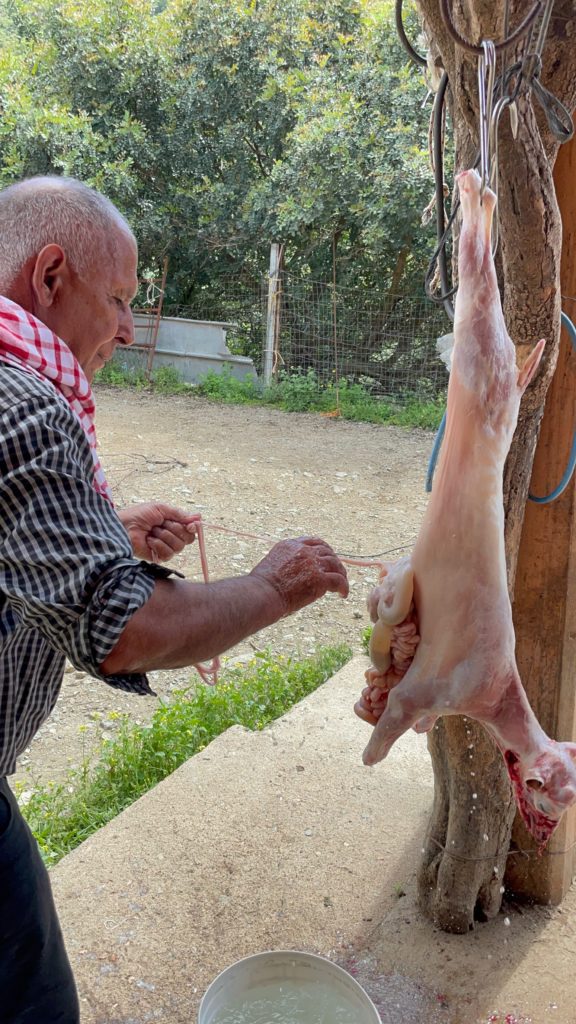
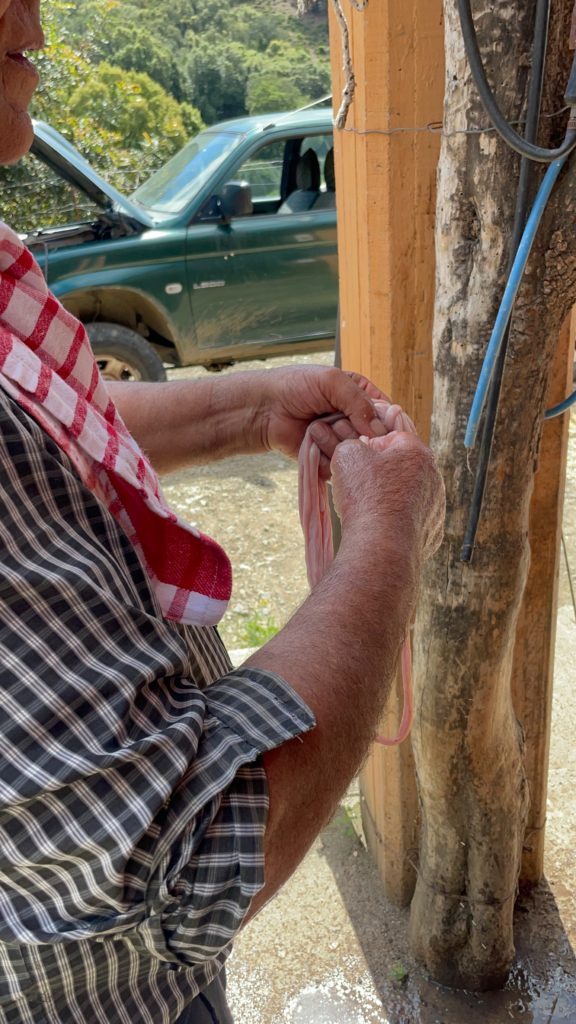
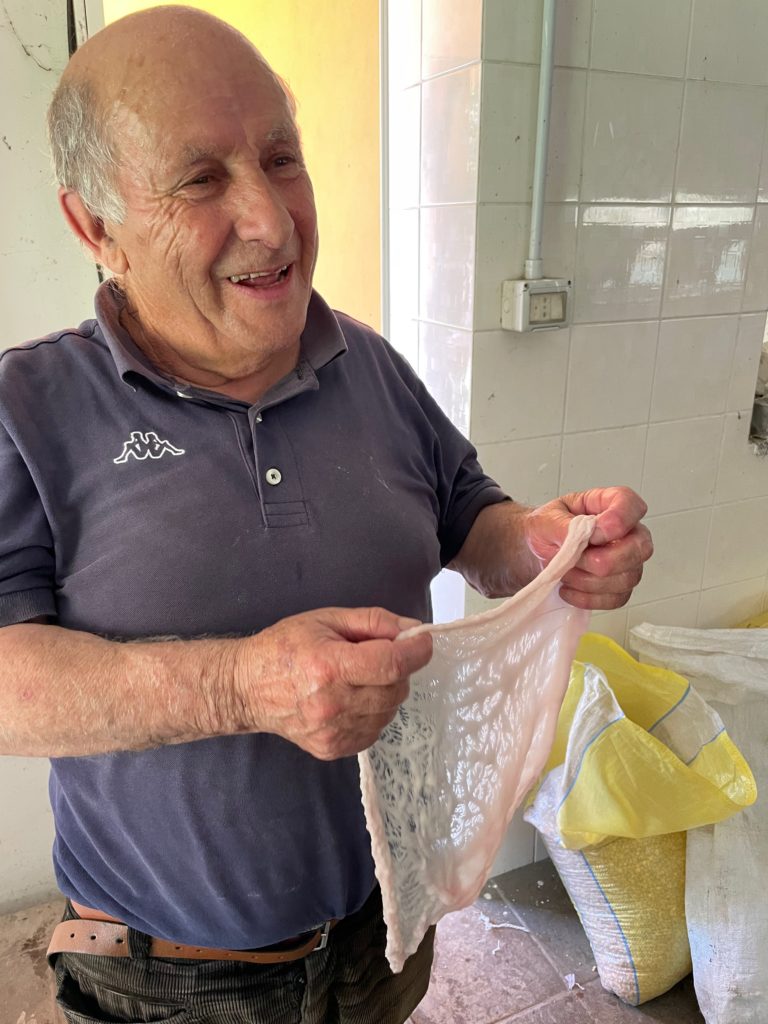
Working like an artist with offal
Salvatore took all of the offal – the liver, spleen, heart, lungs – and cut them into smaller pieces measuring approximately 2-3 inches on each side. Then, he pulled out a piece of pancetta (Italian cured, unsmoked bacon) and sliced it into approximately ¼ inch thick pieces. Now it was time to make the tratelleria.
Building the tratelleria began by placing each piece of offal on a large, sword-like kebab spike. After a sequence of liver, heart, lung and spleen were in place, Salvatore followed with a piece of pancetta. Then, the sequence began all over again. Once all the organs had been skewered the caul fat was used to cover everything. Then it was wrapped with the flushed large intestines followed by the small intestines still filled with the chyme. In addition to holding everything together, the wrapping of intestines also made it look beautiful. And, as we would soon find out, they created a delicious, crusty coating when cooked.







As a final preparation for cooking, Salvatore affixed a piece of lardo (cured pig fat) on the end of a long stick then stuck a smaller stick measuring approximately 3 inches long stuck into one side of it. What seemed odd at the time soon turned out to be a fantastic outdoor cooking hack I will definitely use in the future.
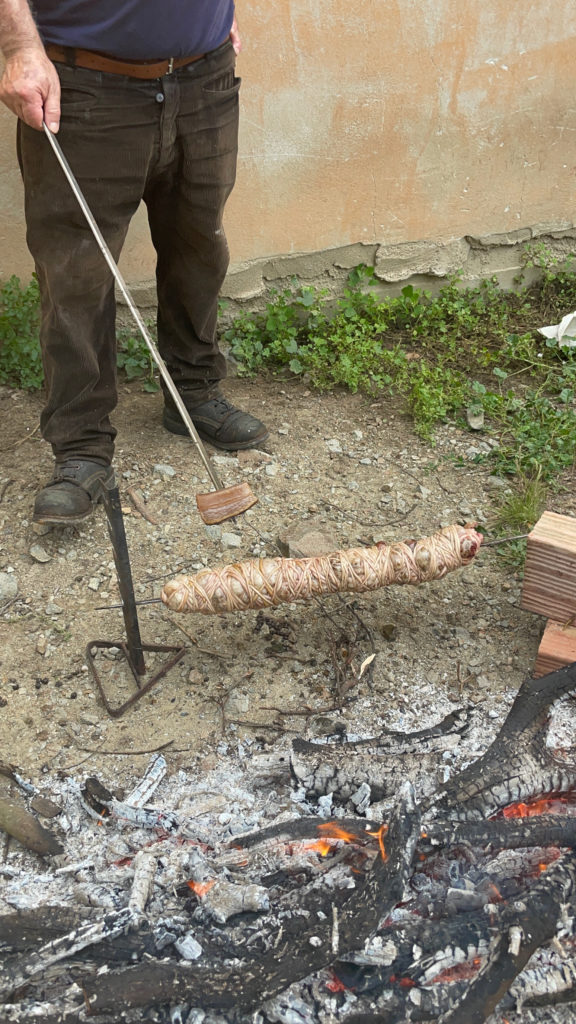
The two skewers, one holding the tratelleria and the other holding the carcass, kidneys and head were placed on either side of the fire and affixed to two homemade rotisserie contraptions built out of old car parts. These machines slowly turned the skewers to ensure even cooking. Part way through the cooking process we learned the purpose of the “lardo on a stick.” The shepherds would periodically heat the lardo over the fire until it began to melt then baste both the tratelleria and roasting goat with the melted lardo by allowing it to run down the smaller stick inserted in the side….brilliant!
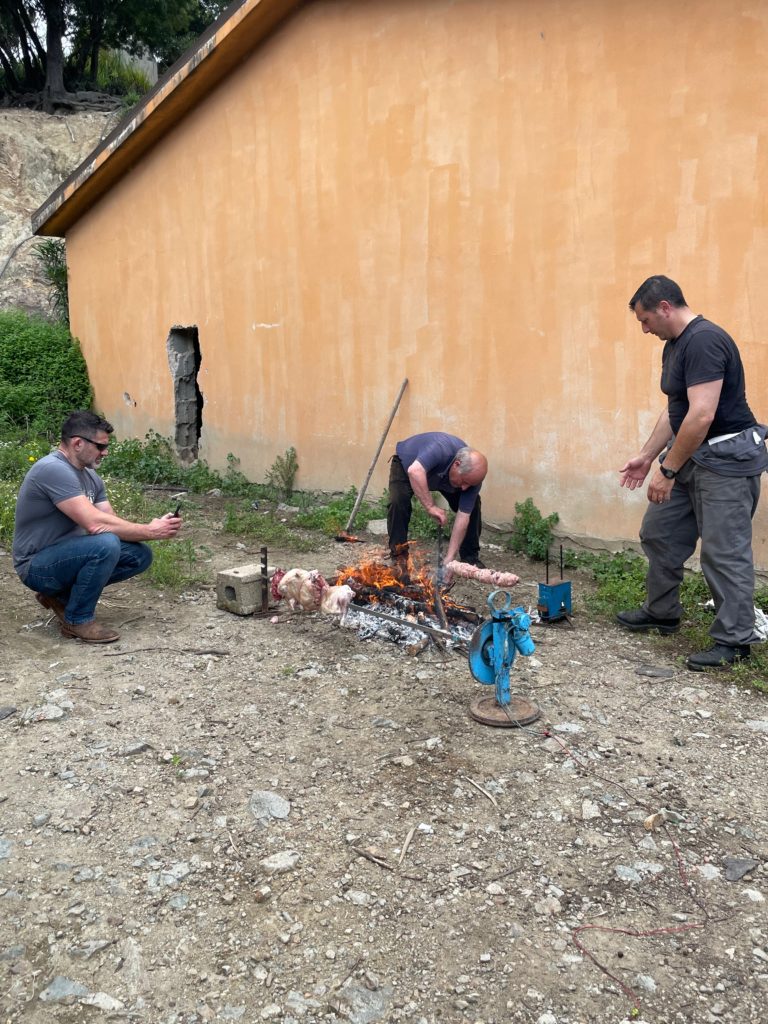
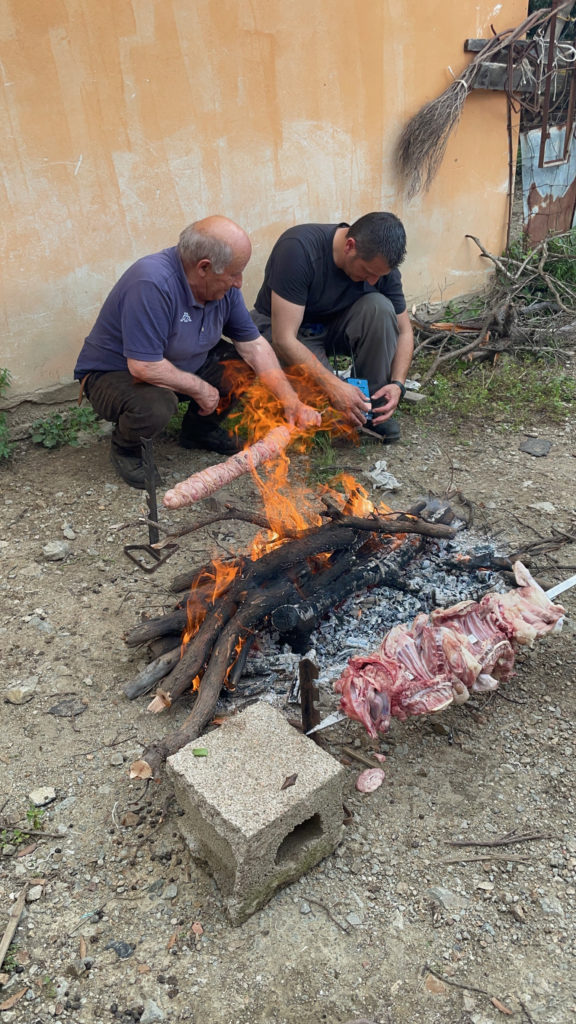
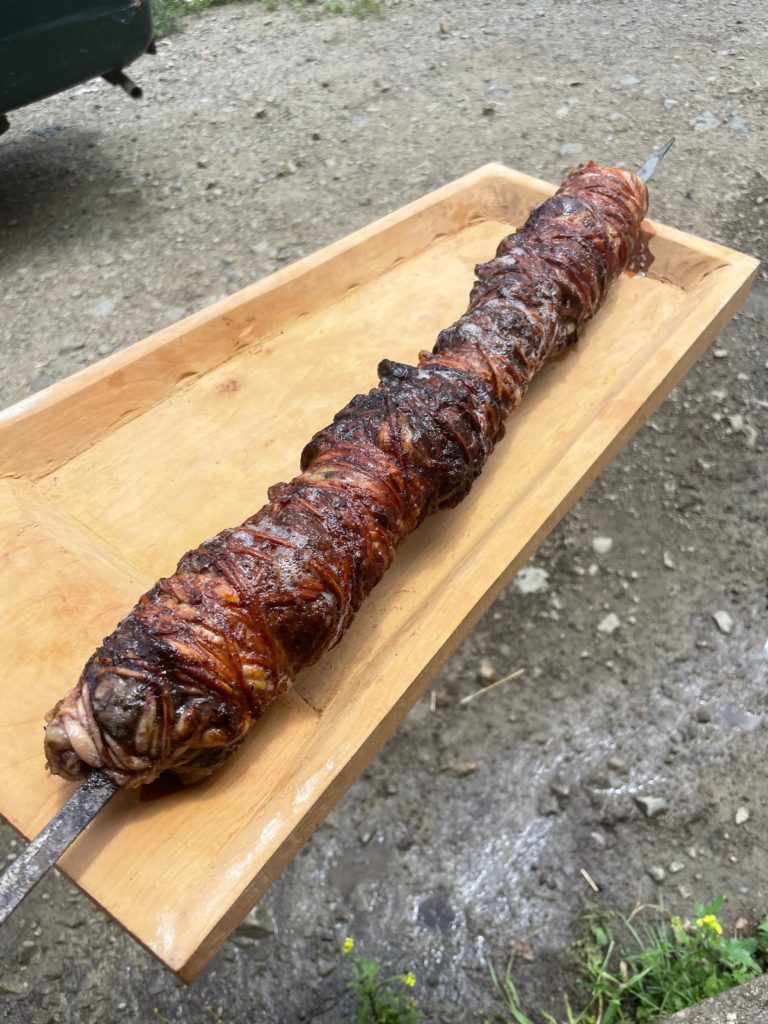
Lunch is served!
Approximately 3 hours later lunch was served! The table that earlier served as a butchering surface was cleaned and covered with a tablecloth. Plates, forks and cups were arranged at our seats and food was placed in the center. We started the meal with fresh sour cheese (casu asceau) that Giovanni made along with prosciutto and salami that Andrea cured from his own pigs.






The meal progressed through courses of different traditional Sardinian foods but the highlight of the meal was the su tratelleria and roast goat that we had all prepared together throughout the day. To serve the su tratelleria, it was removed from the skewer and cut into rounds while the roast goat was cut into manageable pieces. It was delicious, all of it! Christina and I both commented on the fact that the tratelleria consisted of a combination of textures and flavors from the crunchy outside encasing the offal. And, we genuinely enjoyed it all.








True connection through food
Everything about this day was nourishing, fulfilling and beautiful. But, it certainly didn’t have to be – just think about it. The day began with a slightly treacherous, bumpy ride down a rock slope of a mountain in the bed of a pick up truck to a remote shepherd’s “cabin” with no electricity to work with shepherds we had never met. It involved death and blood and unfamiliar foods complete with unfamiliar flavors, textures and aromas. There was also a language barrier. The shepherds spoke Italian and Sardinian and we spoke English.
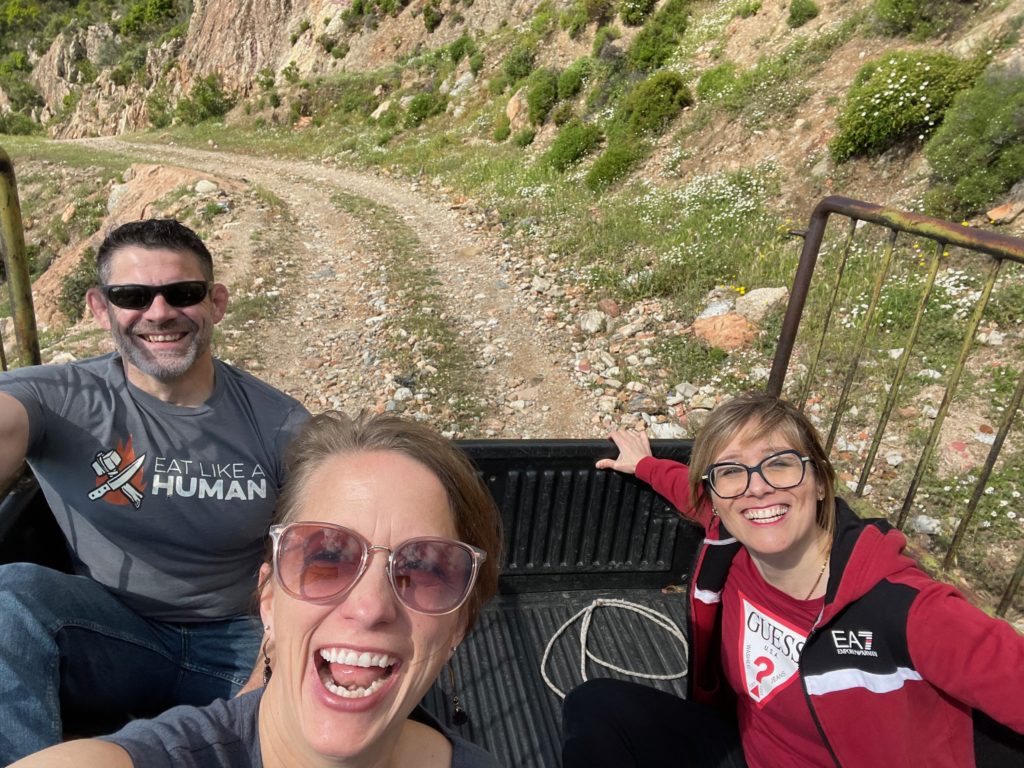
What made this day special, however, was the connection it provided.
We were working with and learning from beautiful humans who wanted nothing more than to share their traditional foodways they were so proud of. We were a part of the entire process from slaughtering and butchering to cooking and sharing a meal of the entire goat (minus the hide, feet and gallbladder). Every single aspect of the day was steeped in tradition and we experienced it all using every one of our senses. It is through genuine connections such as this that the flaws in our modern industrial food system become so incredibly apparent.
Our modern industrial food system does not connect; rather, it insulates us. It is this very insulation from the death and processing of the animals we rely on for our food has allowed the modern meat industry to grow and spin out of control.
I realize that many of us feel safe and content insulated from the realities of where our meat comes from. But, I assure you that ignorance is not bliss and is wreaking havoc on the environment, animals, small conscientious farmers, and our health. The current system is not ethical, sustainable, nor nourishing. And, the answer is not to stop eating meat.
What can I do?
- It is time to reconnect to our food system,
- Remove links from our food chain,
- Support local, small-scale conscientious farmers, abattoirs, and butchers, and
- Cook as much as we can at home using a whole animal, nose-to-tail approach!

In case you missed the first post in this series, make sure you go back and read about the callu di cabrettu (cheese made from an unweaned calf’s stomach)
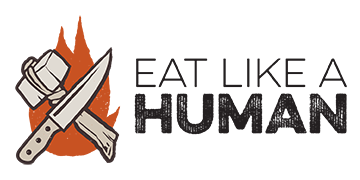
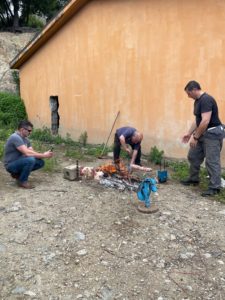
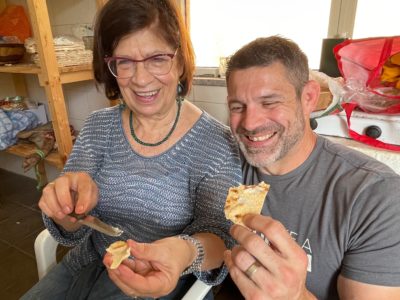


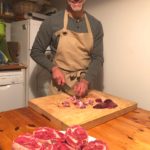
 do you have the stomach for it?
do you have the stomach for it?
This? In Sardinia? I guess that means the “Mediterranean” diet isn’t quite what we’ve been told it is, eh? 😉 What an incredible cultural and culinary experience.
You’ve got that 100% right! We barely saw any vegetables let alone minestrone soup!